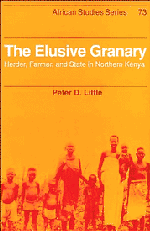Book contents
- Frontmatter
- Contents
- List of illustrations
- List of tables
- Preface
- 1 Introduction: the study of agrarian change among African herders
- 2 Society, ecology, and history
- 3 Markets and the state
- 4 Labor and agropastoral production
- 5 Income, wages, and investment
- 6 Expenditures, consumption, and the food crisis
- 7 Land conflicts and sustainability
- 8 In pursuit of the granary: development responses of community, donor, and state
- Notes
- References
- Index
- AFRICAN STUDIES SERIES
1 - Introduction: the study of agrarian change among African herders
Published online by Cambridge University Press: 04 August 2010
- Frontmatter
- Contents
- List of illustrations
- List of tables
- Preface
- 1 Introduction: the study of agrarian change among African herders
- 2 Society, ecology, and history
- 3 Markets and the state
- 4 Labor and agropastoral production
- 5 Income, wages, and investment
- 6 Expenditures, consumption, and the food crisis
- 7 Land conflicts and sustainability
- 8 In pursuit of the granary: development responses of community, donor, and state
- Notes
- References
- Index
- AFRICAN STUDIES SERIES
Summary
A group of elders huddle in the shaded area outside a small retail store, seeking reprieve from the midday heat of northern Kenya. The wind swirls a red glow of sand that eventually covers everything in its path. Conversation among these herders focuses on the latest development initiative in the area – irrigated agriculture – and the possibilities for wage employment that it might create. Their lowkeyed tone implies that they are not particularly enthusiastic about the prospect. Their herds have been devastated by the droughts of the 1980s, and they find themselves especially vulnerable now, as well as increasingly dependent on wage employment and nonpastoral foods (imported grains, for example). While droughts are a normal occurrence in the dry regions of Africa, herders are confronted with processes of change that go well beyond the effects of climate. Their economies and their social structures are clearly in a state of transition – and nowhere is this more apparent than in northern Kenya.
The study of agrarian change in Kenya has a long history that has provided excellent data and a number of analytical insights (Kitching 1980; Leys 1974; Cowen 1981; Collier and Lai 1986). Kenyan materials figure prominently in recent dialogues on the agrarian “crisis” in Africa, a topic of widespread interest to journalists, academics, and policy makers (Berry 1984; Cohen 1988; Commins et al. 1986). The geographic coverage of Kenya, however, has been uneven. Both theoretical and empirical work concentrate mainly on the country's central highlands, where commoditization of land and labor are widespread, and where state and capitalist enterprises have a long history of relationships with rural communities.
- Type
- Chapter
- Information
- The Elusive GranaryHerder, Farmer, and State in Northern Kenya, pp. 1 - 16Publisher: Cambridge University PressPrint publication year: 1992



